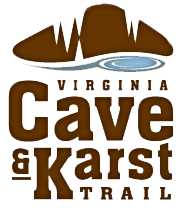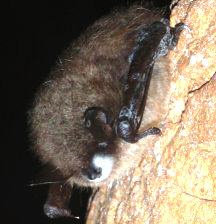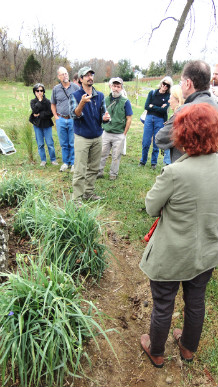
 Department of Conservation and Recreation
Department of Conservation and Recreation
Conserve. Protect. Enjoy.
 Department of Conservation and Recreation
Department of Conservation and Recreation
The Virginia Cave Board (VCB), originally known as the Virginia Cave Commission, was established by the Virginia General Assembly in 1979. This state advisory board is composed of 12 members. Eleven are appointed by the Governor for four-year terms and are selected based on their activities and knowledge of the conservation, exploration, study and management of caves. The Director of the Virginia Department of Historic Resources serves as the twelfth member—ex-officio. By agreeing to serve, the members at a minimum will work to:
The VCB has worked independently and in collaboration with many organizations and the Virginia Department of Conservation and Recreation (DCR) to promote the conservation and protection of caves, karst, cave life and environmental education. The following are highlights of many past and current projects.
CONSERVATION
VCB members assist federal and state agencies and local governments, as well as private groups such as The Nature Conservancy, on setting conservation priorities for cave and karst ecosystems, and making sound decisions on project sites and compatible development in karst landscapes.
Over the years the VCB has placed Cave Protection Signs in selected significant caves in Virginia. The latest sign is shown here.
STATE BAT
The VCB proposed the Virginia Big-eared bat (Corynorhinus townsendii virginianus) as a candidate for the state bat. On March 22, 2005, Governor Mark Warner signed the legislation designating it as the official state bat of the Commonwealth of Virginia.
VIRGINIA CAVE OWNERS’ NEWSLETTER
The Virginia Cave Owners' Newsletter, a publication of the VCB, distributed to over 1,100 landowners in Virginia who have caves on their property. This newsletter's intent is to educate the owners about caves, their contents and groundwater, especially with regard to contamination of springs and wells, as well as sinkhole contamination in karst regions.
VIRGINIA CAVE AND KARST TRAIL

EDUCATION
The VCB responds to inquiries from the public for information and literature and participates in educational events, such as Virginia Cave Week. The Virginia Cave Week website, managed by "Friends of the Cave Board," includes information on cave and karst conservation, commercial cave participation, links to cave conservation organizations, and lesson plans with bibliography for use by classroom teachers.CONSULTATION
The VCB, serving in its role as an advisory board, consults with various agencies and local governments on Environmental Reviews and has participated in discussions on state regulations regarding caves and karst and the importance of their protection. In addition, the Board has worked with the Virginia Department of Historic Resources in permitting the excavation and removal of any archaeological, paleontological, prehistoric and historic features in a cave, worked with the Virginia Department of Wildlife Resources, the state agency that owns the most caves in Virginia,, on the gating of significant caves where appropriate; and worked with the DCR and the Virginia Department of Wildlife Resources on preparing management plans for state-owned caves.
The VCB developed karst assessment standard practices to assist investigators in conducting preliminary assessments in karst landscapes, which will assist jurisdictional regulators and engineers in determining the minimum elements that should be expected in a site evaluation. Karst Assessment Guidelines.
PUBLICATIONS AND PROGRAMS
In its ongoing role to provide information about caves and their protection, members of the Board have presented over 100 lectures and programs on karst, caves, management and environmental issues since its beginning.
Members of the VCB have published articles and brochures on a variety of related subjects. Among the most recent and notable publications are A Brief History of Biospeleology in Virginia by Dr. John Holsinger and The Invertebrate Cave Fauna of Virginia which appeared in Banisteria (The Journal of the Virginia Museum of Natural History, Number 42). The second article was a collaborative effort by former VCB members Dave Culver (lead author), John Holsinger, and David Hubbard with DCR staff Chris Hobson and Wil Orndorff.
COMMERCIAL CAVES
VCB members work with owners, managers and lead guides on interpretation of caves, karst and groundwater at commercial caves in order to improve the manner in which caves and their environmental importance are presented to visitors.
The VCB is concerned with maintaining the natural condition of speleothems within caves to the greatest extent possible. Artificial cave lighting promotes the growth of algae, moss, ferns and other photosynthetic organisms, collectively called "lampenflora." Recommendations are found at VCB Lampenflora Abatement.
ARCHAEOLOGY
Members of the VCB have investigated and inventoried many caves throughout Virginia containing archaeological material. Steps have been taken to ensure preservation of these resources.
BATS AND WHITE-NOSE SYNDROME
White-Nose Syndrome (WNS) now affects bats in all cave and karst regions of Virginia. Populations of Little Brown bats (Myotis lucifugus), Tricolored bats (Perimyotis subflavus), and Northern Long-eared bats (Myotis septentrionalis) have been reduced by over 90 percent, and the federally endangered Indiana bat (Myotis sodalis) is also affected.

Eastern small-footed bats (Myotis leibii) are also affected, but low population numbers and a lack of pre-WNS data make it nearly impossible to quantify effects. Big Brown bats show no changes in numbers and Gray bats (Myotis grisescens), which in Virginia are known only in the Upper Tennessee River Basin, are not experiencing die-offs despite several years of exposure to the pathogen. Virginia Big-eared bats (Corynorhinus townsendii), continue to be unaffected despite exposure to the pathogen.
Dr. David Blehert (microbiologist at the USGS National Wildlife Health Center) has stated: "While our study confirmed that Geomyces destructans [now known as Pseudogymnoascus destructans] is spread bat-to-bat, it is also important to note that virtually all pathogens, especially spore-producing fungi, are spread by multiple routes. This is the reason that in an effort to further control the spread of white-nose syndrome, resource management agencies have implemented universal precautions, including limiting human access to sensitive environments occupied by bats, decontaminating equipment and clothing moved between these environments, and restricting the movement between sites." The VCB, the first such State organization to establish statewide procedures, developed new Virginia Cave Board Recommendations Regarding Caving and White-Nose Syndrome (April 30, 2013) and has posted them at White-Nose Syndrome.
CAVE MANAGEMENT PROGRAMS

VCB members have presented cave management programs at seminars for land managers from the U.S. National Park System, U.S. National Forest Service, and other Federal and State agencies from 1989 to 2014. Additionally, members of VCB have actively participated in Appalachian Karst Symposiums, International Congresses of Speleology, Natural Areas Association Conference, and many other technical conferences and field trips that have attracted scientists and others from academia, government, and the private consulting sector.
VCB members are frequently contacted by media about caves, bats, and the environmental sensitivity of karst resulting in many news articles and spots on radio, TV, and in video productions. (Picture courtesy of AGU Blogosphere, October 30, 2012)
VIRGINIA SPELEOLOGICAL SURVEY
The Virginia Speleological Survey, VSS Website, on behalf of the Board, gathers and maintains an informational and survey database on Virginia caves, and to some degree, karst springs. The definition of the length of a cave varies by county survey. The definition of a cave varies by states and regions. Taking a dual reporting criteria of a 5 feet and 30 feet in length (understanding the results are not additive), Virginia has 3,804 caves equal or greater than 5 feet in length, or 2,990 caves equal or greater than 30 feet in length. Included in this total are 375 significant caves.
FUTURE OF THE CAVE BOARD
Future efforts of the Cave Board to conserve Virginia's cave resources fall primarily into five broad areas:
HISTORY
Click here to read a paper by Thomas Lera, former chairman of the Virginia Cave Board, The Virginia Cave Board: The First Fifty Years (1966 – 2015), which summarizes the Virginia Cave Protection Act and VCB actions over the last 50 years in its efforts to protect cave and karst resources of the Commonwealth. Images are courtesy of the Virginia Department of Conservation and Recreation except where indicated.

